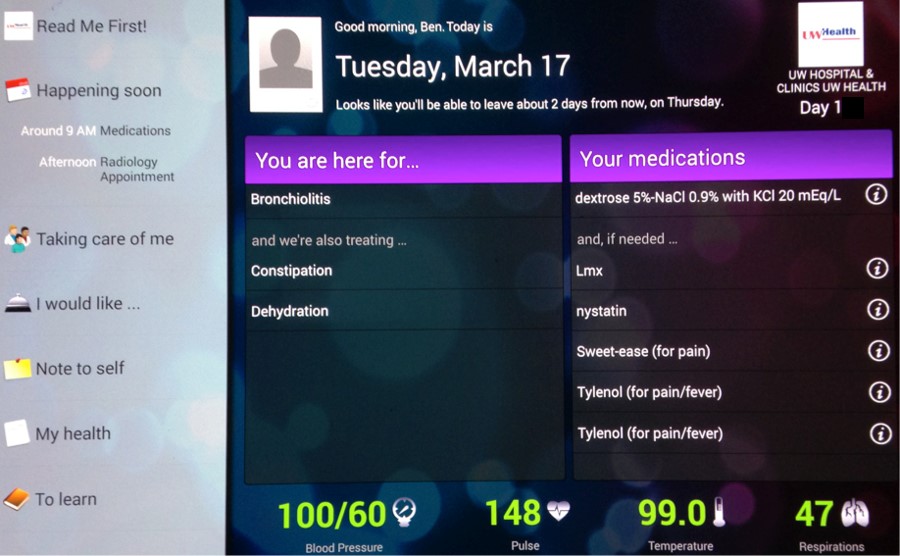- Children and Young Adults
- Datasets and Research Tools
- Engagement in Care
- Engagement in Research
- HIPxChange
- Health IT
- Quality and Safety
- Stakeholder Engagement
*Free registration is required to use the toolkits provided within HIPxChange. This information is required by our funders and is used to determine the impact of the materials posted on the website.
How can portal benefit hospitalized children and their families?
Inpatient portals are intended to engage parents by providing transparency in care while their child is in the hospital.
By having access to clinical information, parents report feeling more in control and empowered to make decisions for their child. Parents also use these portals to identify medical errors. Thus, their use plays an important role in partnering with families to improve the quality and safety of the care of children in the hospital.
Parent testimonials
"It gives you a sense of control... I don't always want to have to ask, 'did this happen, did this get done?' ...it's not that I'm worrying about bothering people, but you also recognize that there's a lot going on, and so it kind of gives you, some of those questions you might have you can get answered."
"I receive the results before the rounds. I have time to prepare, or I search what this result means, and I can ask questions... if I receive the answer onrounds, I don't know how to make decisions..."
"Just to be able to browse through it and know kind of what your child's care is going to look like, because sometimes you can kind of feel alone and like everybody else kind of knows what's going on, but you don't..."
What are the challenges of using portals in the hospital?
Despite the potential benefits for patients and their families, implementation of portals in hospitals can be challenging. Hospital staff have concerns that increasing transparency in the acute setting may lead to confusion and worry for parents and more time spent answering their questions.
Often uncharted territory, the logistics of hardware, privacy and proxy access considerations, timing of result release, strategies for secure messaging and monitoring portal use and impact can be daunting for healthcare organizations.
Our experience implementing an inpatient portal
In 2014, we started offering parents of children hospitalized at our children’s hospital a tablet computer with an inpatient portal, MyChart Bedside, to use throughout their child's hospital stay.
Portal home screen, MyChart Bedside (© 2017 Epic Systems Corporation. Used with permission.)

In general, parents were very positive about using the portal, reporting that the information on it helped them monitor, understand, and make decisions about their child’s care. Overall, 94% of parents agreed that it improved the quality of their child’s care, 89% perceived that use reduced errors and 8% reported finding a medication error using the portal.1,2
While our staff all anticipated challenges to sharing information with families using a portal, 6 months after implementation, all challenges perceived by staff were significantly reduced.3
We had very few calls to our help desk and no tablets broken, lost, or stolen. Based on these results, we now offer all adolescents and parents of children at our hospital access to their healthcare information via the portal throughout their hospital stay.
About the toolkit
Who should use this toolkit?
This toolkit is intended for health care administrators and care team members, information services staff, and researchers interested in using an inpatient portal to engage hospitalized patients and caregivers.
What does the toolkit contain?
We developed this toolkit based on discussions with various organizations requesting practical information about how to implement an inpatient portal.
This toolkit contains:
- Materials to engage institutional stakeholders
- Implementation timeline and planning documents
- Information regarding key decisions and pediatric considerations
- Data collection tools to monitor the impact of the portal, including surveys and interview guides
- Our lessons learned
- Publications and other resources
How should these tools be used?
The materials in this toolkit can be used to guide the introduction, implementation, and/or evaluation of an inpatient portal.
While developed at a children’s hospital implementing a specific portal, MyChart Bedside, most materials could also be used to implement inpatient portals in general in either a pediatric or adult setting.
The entire toolkit can be downloaded in PDF format. In addition, to allow you to easily adapt the instruments for use in your organization, they are provided in Microsoft Word/Excel that you can download on the HIPxChange site.
Development of this toolkit
This toolkit continues to be developed by parents, hospital administrators, care team members, information services representations and researchers at UW Health, the American Family Children’s Hospital, the University of Wisconsin School of Medicine and Public Health, and the Center for Quality and Productivity Improvement.
This project was supported by a research and development grant (Principal Investigator: Michelle M. Kelly, MD) from the Department of Pediatrics’ at the University of Wisconsin School of Medicine and Public Health. Additional support was provided by the University of Wisconsin School of Medicine and Public Health’s Health Innovation Program (HIP), the Wisconsin Partnership Program, and the Community-Academic Partnerships core of the University of Wisconsin Institute for Clinical and Translational Research (UW ICTR), grant 9 U54 TR000021 from the National Center for Advancing Translational Sciences (previously grant 1 UL1 RR025011 from the National Center for Research Resources). The content is solely the responsibility of the authors and does not necessarily represent the official views of the National Institutes of Health or other funders.
Toolkit Citation
Kelly MM, Hoonakker PLT, Dean SM. “Partnering with parents of hospitalized children using an inpatient portal." Madison, WI: University of Wisconsin School of Medicine and Public Health Department of Pediatrics, Center for Quality and Productivity Improvement, Institute for Clinical and Translational Research, and UW Health Innovation Program; 2017. Available at: https://www.hipxchange.org/Inpatientportal.
References
- Kelly MM, Hoonakker PLT, Dean SM. Using an inpatient portal to engage families in pediatric hospital care. J Am Med Inform Assoc 2017;24(1): 153-161
- Kelly MM, Hoonakker PLT, Dean SM, Plotkin JA, Klagos SJ, Byrne BJ. (2016) Improving medication safety through an inpatient portal for families of hospitalized children. In Mollo, V. and Falzon, P. (Ed), Proceedings of the Healthcare Systems Ergonomics and Patient Safety Conference. Toulouse, France, pp. 222-226.
- Kelly MM, Dean SM, Carayon P, Wetterneck TB, Hoonakker PLT. Healthcare team perceptions of a portal for parents of hospitalized children before and after implementation. Appl Clin Inform 2017;8(1):265-78.






